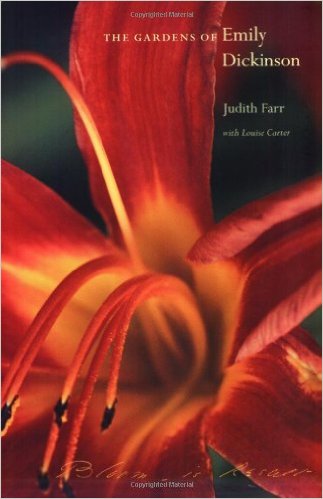 The Gardens of Emily Dickinson
The Gardens of Emily Dickinson
by Judith Farr
Harvard Univ. Press. 350 pages. 26.95
EMILY DICKINSON inhabited a world of daisies, calla lilies, bourbon roses, sweet sultans, and verbena (among other flowers), not only in her symbolic use of such flowers in her poetry, but literally, as a horticulturalist who spent many hours cultivating her garden.
Born in 1830 to a prominent family, Dickinson lived in Amherst, Massachusetts (where her grandfather had helped to found Amherst College) until her death in 1886. Starting in her youth, Dickinson—shy, sensitive, and introspective—had written poems to family and friends. In The Gardens of Emily Dickinson, author Judith Farr, author of The Passion of Emily Dickinson (1992) and professor emeritus of English at Georgetown University, describes how young Emily dispatched the verse in letters or with elegant bouquets of flowers that she gathered from nearby fields or cultivated in the garden of Homestead, her family’s fourteen-acre Federal Revival mansion and estate. Supportive of her gardening habit—a mainstay of well-bred Victorian women—her father later built for Emily a glass conservatory (a greenhouse) that sustained her devotion to plants and flowers during those harsh New England winters.
Shortly after Dickinson’s funeral—which was held in the parlor of Homestead, her body adorned with heliotrope, violets, and pink cypripedium—her sister Lavinia, going through Emily’s effects, discovered a small box containing nearly 1,000 poems. The pages of verse were bound in dozens of hand-stitched fascicles, or manuscript volumes. Many scholars have suggested that this was Dickinson’s response to an 1862 letter from Thomas Wentworth Higginson, an influential critic, who had pronounced four poems she’d sent him as “too delicate” for publication. In the aftermath of her correspondence with Higginson, Dickinson wrote a now famous poem with an opening quatrain that reads: “Publication is the Auction/ Of the Mind of Man/ Poverty be justifying/ For so foul a thing.” Determined to bring Emily’s poignant and prophetic artistry to light, Lavinia Dickinson arranged for the 1890 publication of Poems by Emily Dickinson.
As Farr tells it—in prose suitable for Dickinson aficionados, literary scholars, weekend gardeners, and horticulture experts alike—flowers provided both poetic inspiration and personal solace to a woman for whom intimacy always presented a mighty challenge: “The constraints of [Dickinson’s] life that provided freedom to write—celibacy, semi-isolation, anxiety—gave pain to others.” Referencing such contemporary works as Flora’s Lexicon: An Interpretation of the Language and Sentiment of Flowers (1839) and The Flower Vase (1843), Farr suggests that Dickinson cunningly crafted poems with allusions to flowers and gardening that conveyed deep emotional, and sometimes erotic, feelings that she could not otherwise express.
One example is an 1860 poem in which Dickinson wrote: “The Daisy follows soft the Sun/ And when his golden walk is done/ Sits shyly at his feet.” Farr explains that during the Victorian era the daisy “invariably connotes innocence,” adding that the flower as Dickinson presents it in this poem also symbolizes a coy, coquettish tease. Farr notes that at the time the poem was written, Dickinson had given “marks of extraordinary favor” to Samuel Bowles, a married activist editor of a newspaper routinely read in the Dickinson household. She points out that Bowles, himself a gardener and frequent visitor to Homestead, would have been familiar with the poem’s coded floral imagery.
Those looking for lengthy discourse on the longstanding debate about Dickinson’s sexual orientation will find no headline news in this book. Farr observes that this old mystery has already been probed in countless other works, including her own previous scholarship. Still, many readers will find intriguing Farr’s brief discussion of the diverse people who purportedly aroused Dickinson’s desire: the married Samuel Bowles; a widower judge; a Congregationalist minister; several female schoolmates; the wife of the editor of Scribner’s magazine; a “handsome” adult woman friend; and—the object of increasing speculation on the lesbian front—Emily’s sister-in-law, Susan Gilbert Dickinson. As Farr put it, Susan was a powerful woman of “fine carriage and dark good looks.”
Farr reveals that in Dickinson’s poems and letters, Susan (with whom Emily corresponded for forty years) is assigned characteristics of Shakespeare’s Cleopatra and that the poet frequently presents her in the company of cardinal flowers and the “Crown Imperial.” “Emily reports herself deeply moved when Susan, her chief or cardinal friend, sends her a cardinal flower,” Farr writes. During the winter season, when Dickinson was 48 years old, she wrote to her sister-in-law: “I dreamed of you, last night, and send a Carnation to indorse [sic]it.” She dispatched the flower with a poem: “Sister of Ophir/ Ah Peru/ Subtle the Sum/ That purchase you.” Farr explains that the carnation, unable to withstand cold climates, would have been cultivated in Dickinson’s conservatory. “Emily’s gift—a poem and a flower—is a tribute, then, to Susan’s importance: she is richly endowed with brilliance … and she is precious, like the greenhouse carnation.”
In The Gardens of Emily Dickinson, Farr also offers an intriguing analysis of an eye ailment from which the poet suffered that might have contributed to her rush of poems and her reputation as an eccentric. Farr writes that in the late 1850’s Dickinson developed anterior uveitis, a painful malady that causes intolerance to light. Fearful that the disease might render her blind, Dickinson began to write feverishly, producing more than 300 poems in one year. Unable to endure direct sunshine, she began to garden at night. In lyrical words, reminiscent of William Luce’s famous play about Emily Dickinson, The Belle of Amherst, Farr writes: “Her neighbors recalled glimpsing a white figure, slightly illuminated by lantern light, kneeling in the darkness above her lobelia and sweet sultans.”
Evelyn C. White is author of Alice Walker: A Life and editor of The Black Women’s Health Book.






